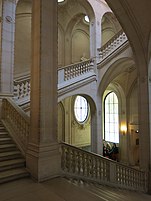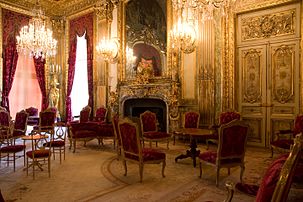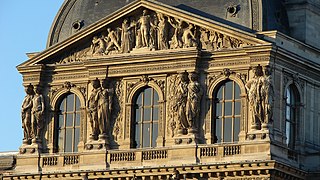Napoleon III's Louvre expansion

The expansion of the Louvre under Napoleon III in the 1850s, known at the time and until the 1980s as the Nouveau Louvre
The project was initially intended for mixed ceremonial, museum, housing, military and administrative use, including the offices of the ministère d’Etat and ministère de la Maison de l'Empereur which after 1871 were attributed to the
Project development

Following the French Revolution of 1848, the provisional government adopted a decree on the continuation of the rue de Rivoli toward the east and the completion of the Louvre Palace's north wing, building on the steps taken to that effect under Napoleon. Architect Louis Visconti and his disciple Émile Trélat produced a draft design for completing the entire palace and presented it to the Legislative Assembly in 1849.[2]: 155 These plans were not implemented, however, until President Louis-Napoleon was in a position to prioritize them following his successful coup d'état on 2 December 1851, even before he would formally rebrand himself as Emperor Napoleon III.[5] On Louis-Napoleon's order, Minister François-Xavier Joseph de Casabianca commissioned Visconti to design the new Louvre's plans on 30 January 1852,[6] and the first stone was laid on 25 July 1852.[2]: 155
After Visconti died of a heart attack on 29 December 1853,
The young American architect Richard Morris Hunt, who had studied under Lefuel at the École des Beaux-Arts, worked on the Louvre as a junior architect between April 1854 and September 1855, as also did Italian architect Marco Treves from May 1854 to September 1857.[7] Following Hunt's graduation, Lefuel made him inspector of the Louvre work and allowed him to design the façade of the Pavillon de la Bibliothèque facing the rue de Rivoli.[8]
-
One of many earlier unrealized proposals for the completion of the Louvre, by Percier and Fontaine (1807 or 1808)
-
Plan of the unfinished Louvre by Charles Vasserot, showing the jumble of buildings on the location of the present-dayCour Napoléon(1830)
-
Design of the Louvre expansion by Louis Visconti (1853)
-
Visconti presents the plans for the Nouveau Louvre to Emperor Napoleon III and Empress Eugénie in 1853 at the Tuileries, painting by Jean-Baptiste-Ange Tissier (1865)
-
Engraving dedicated "to His Majesty the Emperor" showcasing Visconti's design, by Rudolf Pfnor (1853)
-
Celebratory tapestry cartoon[4] showing the expanded Louvre between a cherub holding a ribbon inscribed with "LE LOUVRE DE NAPOLEON III" (lower left) and two angels holding the emperor's profile (upper right), by Victor Chavet (1857); now at the Louvre
Description
The Nouveau Louvre mostly consists of two sets of buildings or wings, on the northern and southern sides of the central space that is now called the Cour Napoléon. The new buildings were structured around a sequence of pavilions that were given names of French statesmen from the
Lefuel created two octagonal gardens at the center of the Cour Napoléon (now replaced by the Louvre Pyramid). In multiple parts of the project, Napoleon III emphasized his role as continuator of the great French monarchs of the past, and as the one who completed their unfinished work. On both sides of the Pavillon Sully, black marble plaques bear gilded inscriptions that read, respectively: "1541. François Ier commence le Louvre. 1564. Catherine de Médicis commence les Tuileries," and "1852-1857. Napoléon III réunit les Tuileries au Louvre."[2]: 156 Separately, Napoleon III created a Musée des Souverains in the Louvre's Colonnade Wing to similarly emphasize the continuity of his rule with the long legacy of French monarchy and thus bolster his legitimacy.
On the eastern side of the Cour Napoléon, the project entailed no new building but rather the exterior refacing of the pre-existing palace whose interior rooms were left unchanged. For the central
Inside the North Wing were prestige apartments for some of the regime's principal figures, including those of the Minister of State (long mistakenly attributed to the
The South Wing was largely devoted to a series of new spaces for the
Below these prestige spaces was an extensive complex of stables for up to 149 horses and 34 carriages.
-
North Wing
-
Escalier du Ministre
-
Escalier Lefuel
-
Escalier Colbert
-
Appartements Napoléon III
-
Appartements Napoléon III
-
Galerie Daru
-
Salle Daru
-
Pavillon Denon ceiling
-
Cour Lefuel with ramps to the salle du Manège
-
Interior of the salle du Manège
-
Pavillon de la Bibliothèque on the rue de Rivoli
Statuary

Initially, Visconti's plan was to erect equestrian statues of
Nevertheless, sculptural profusion was one of the defining features of Lefuel's approach. Arguably the most salient component is the series of 86 statues of celebrated figures (hommes illustres) from French history and culture, selected by Napoleon III himself,[19] each one labelled with their name. These include, following the order of the wings from northwest to southwest:
- North Wing, western side: La Fontaine, by Jean-Louis Jaley; Pascal, by François Lanno; Mézeray, by Louis-Joseph Daumas; Molière, by Bernard Seurre; Boileau, by Charles Émile Seurre; Fénelon, by Jean-Marie Bonnassieux; La Rochefoucauld, by Noël-Jules Girard; and Corneille, by Henri Lemaire.
- North Wing, southern side: Vauban, by Gustave Crauck; Lavoisier, by Jacques-Léonard Maillet; and Jérôme Lalande, by Jean-Joseph Perraud.
- Eastern side of the Cour Napoléon: Louvois, by Aimé Millet; Saint-Simon, by Pierre Hébert; Joinville, by Jean Marcellin; Esprit Fléchier, by François Lanno; Commynes, by Eugène-Louis Lequesne; Jacques Amyot, by Pierre Travaux; Mignard, by Debay fils; Massillon, by François Jouffroy; Jacques I Androuet du Cerceau, by Georges Diebolt; Jean Goujon, by Bernard Seurre; Claude Lorrain, by Auguste-Hyacinthe Debay; Grétry, by Victor Vilain; Jean-François Regnard, by Théodore-Charles Gruyère; Jacques Cœur, by Élias Robert; Enguerrand de Marigny, by Nicolas Raggi; Chénier, by Auguste Préault; Jean-Balthazar Keller, by Pierre Robinet; and Antoine Coysevox, by Jules-Antoine Droz.
- South Wing, northern side: Jean Cousin the Younger, by Napoléon Jacques; Le Nôtre, by Jean-Auguste Barre; Clodion, by Vital-Dubray; Germain Pilon, by Louis Desprez; Ange-Jacques Gabriel, by Augustin Courtet; Le Pautre, by Bosio the Younger; Michel de l'Hôpital, by Eugène Guillaume; Lemercier, by Antoine Laurent Dantan; Descartes, by Gabriel Garraud; Ambroise Paré, by Michel-Pascal; Richelieu, by Jean-Auguste Barre; Montaigne, by Jean-François Soitoux; Houdon, by François Rude (copy); Étienne Dupérac, by Jacques Ange Cordier; Jean de Brosse, by Auguste Ottin; Cassini de Thury, by Hippolyte Maindron; d'Aguesseau, by Louis-Denis Caillouette; Hardouin-Mansart, by Jean-Joseph Perraud; Poussin, by François Rude (copy); Gérard Audran, by Jacques-Léonard Maillet; Jacques Sarazin, by Honoré-Jean-Aristide Husson; Nicolas Coustou, by Augustin Courtet; Le Sueur, by Honoré-Jean-Aristide Husson; Claude Perrault, by Auguste-Hyacinthe Debay; Philippe de Champaigne, by Louis-Adolphe Eude; and Puget, by Antoine Étex.
- South Wing, western side: Lescot, by Henri de Triqueti; Bullant, by Pierre Robinet; Le Brun, by Jean-Claude Petit; Pierre Chambiges, by Jules-Antoine Droz; Libéral Bruand, by Armand Toussaint; Philibert de l'Orme, by Jean-Pierre Dantan; Palissy, by Victor Huguenin; and Rigaud, by Victor Thérasse.
Among the abundant architectural sculpture of the Nouveau Louvre, the pediments of the three main pavilions stand out:[2]: 156 [20]
- Pavillon Richelieu: "France distributing crowns to its worthiest children", by Francisque Joseph Duret (in which the figure of France has been viewed as a likeness of Empress Eugénie[21]: 70 );
- Pavillon Sully: "Napoleon I above History and Arts", by Antoine-Louis Barye and Pierre-Charles Simart;
- Pavillon Denon: "Napoleon III surrounded by Agriculture, Industry, Commerce and the Fine Arts", by Simart.
The latter group includes the depiction of a steam locomotive, then representing cutting-edge technological progress, and the only surviving public portrayal of Napoleon III in Paris.[22]
-
Pediment, Pavillon Richelieu
-
Pediment, Pavillon Sully
-
Pediment, Pavillon Denon
The South Wing's salle du Manège was another opportunity for Lefuel to foster a rich structural program, which was executed in 1861 after the Nouveau Louvre's inauguration. Outside in the Cour Lefuel, four bronze groups of wild animals by Pierre Louis Rouillard stand at the start of the two horse ramps : Chienne et ses petits, Loup et petit chien, Chien combattant un loup, and Chien combattant un sanglier. At the top of the ramps above the entrance to the manège, a monumental group, also by Rouillard, features three surging horses that echo Robert Le Lorrain's chevaux du soleil at the Hôtel de Rohan (Paris). Inside, the idiosyncratic hunting-themed capitals feature heads of horses and other animals, by Emmanuel Frémiet, Rouillard, Alfred Jacquemart, Germain Demay, and Houguenade.[23]
-
Rouillard's wild animals in the Cour Lefuel
-
Rouillard's "dog fighting a wolf"
-
Rouillard's "wolf and puppy"
-
Rouillard's three horses above the Manège's entrance
-
One of the capitals of the Salle du Manège
Later history


In 1861, the
That setting, however, did not last long, as the Second Empire came to its abrupt end. On 6 September 1870, days after the emperor's capture at the Battle of Sedan, Barye's equestrian statue was topped and destroyed.[24] At the end of the Paris Commune on 23 May 1871, the Tuileries Palace was burned down, as was the Bibliothèque du Louvre. Lefuel, together with Eugène Viollet-le-Duc, defended the option of repairing the ruins, but shortly after both died the French parliament decided to tear them down in 1882, largely for political motives associated with the termination of the monarchy. After the remains of the Tuileries were razed in 1883, the layout that had been created by Napoleon III and Lefuel was fundamentally altered.
In the context of the
Influence

The nouveau Louvre was highly influential and became the exemplar of the
See also
Notes
- ISBN 1167342747.)
{{cite book}}: CS1 maint: location missing publisher (link - ^ a b c d e f g h i Galignani's New Paris Guide, for 1870: Revised and Verified by Personal Inspection, and Arranged on an Entirely New Plan. Paris: A. and W. Galignani and Co. 1870.
- ^ Denise Bernard-Folliot (1984). Guide Bleu Paris. Paris: Hachette. p. 305.
- ^ a b c Karine Huguenaud. "Le Louvre de Napoléon III". Fondation Napoléon.
- ^ S2CID 144533244.
- ^ a b c d e f g h Christiane Aulanier (1953). Le Nouveau Louvre de Napoléon III (PDF). Paris: Editions des Musées Nationaux.
- ^ "Histoire mouvementée d'un fonds d'archives exceptionnel" (PDF). Archives nationales.
- ^ William Roscoe Thayer, ed. (1893), "Richard Morris Hunt", The Harvard Graduates' Magazine, I, Cambridge, Massachusetts: Harvard Graduates' Magazine Association
- ^ L. Vitet (1882), Le Louvre et le Nouveau Louvre, Paris: Calmann-Lévy
- ^ a b Anne Dion-Tenenbaum (1993). Les appartements Napoléon III du musée du Louvre. Paris: Réunion des Musées Nationaux.
- ^ Xavier Mauduit (2008). "Le ministère du faste : la Maison de l'Empereur Napoléon III". Parlement[s], Revue d'histoire politique.
- ^ a b Guy Vidal (January–February 1990). "Le Ministère des Finances de Rivoli à Bercy". La Revue administrative. 43 (253). Paris: Presses Universitaires de France: 71–77.
- ^ "Les prémices du Ministère: Tentatives éphémères d'une administration des Beaux Arts autonome à partir du Second Empire". Ministère de la Culture.
- ^ a b c Henri Verne (1923). Le Palais du Louvre: Comment l'ont terminé Louis XIV, Napoléon Ier et Napoléon III. Paris: Editions Albert Morancé. p. 30.
- ^ Louis Hautecoeur, Louis (1928). Histoire du Louvre: Le Château – Le Palais – Le Musée, des origines à nos jours, 1200–1928. Paris: L'Illustration. p. 102.
- ^ Jean-Claude Daufresne (1987). Louvre & Tuileries : Architectures de Papier. Brussels: Pierre Mardaga.
- ^ Frédéric Lewino; Anne-Sophie Jahn (16 May 2015). "Visite interdite du Louvre #4 : la magnifique rampe en fer à cheval de la cour des Écuries". Le Point.
- ^ "Nouveau Louvre Aile Mollien : Appartement du Grand Ecuyer". France Archives.
- ^ Guy Nicot (1993). Au Louvre : La Cour Napoléon transfigurée. Paris: Réunion des Musées Nationaux. p. 48.
- ^ Georges Poisson (1994), "Quand Napoléon III bâtissait le Grand Louvre", Revue du Souvenir Napoléonien: 22–27
- ^ a b Jacques Hillairet. Dictionnaire historique des rues de Paris. Vol. II. Paris: Editions de Minuit.
- ^ "Le Louvre et Napoléon III". Paris Autrement. 14 January 2014.
- ^ Geneviève Bresc-Bautier (1995), The Louvre: An Architectural History, New York: The Vendome Press, pp. 144, 154
- ^ Michèle Beaulieu (1946). "Les esquisses de la décoration du Louvre au Département des sculptures". Bulletin Monumental. 104.
- ^ Dominique Poiret (28 November 2012). "Les terres cuites d'Olivier Gagnère valorisent Vallauris". Libération.


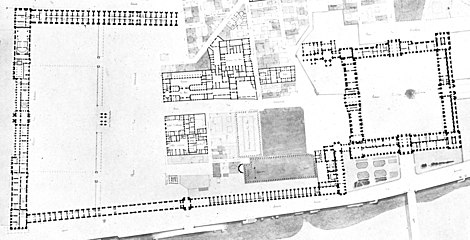
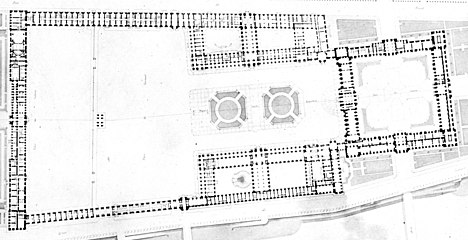


![Celebratory tapestry cartoon[4] showing the expanded Louvre between a cherub holding a ribbon inscribed with "LE LOUVRE DE NAPOLEON III" (lower left) and two angels holding the emperor's profile (upper right), by Victor Chavet [fr] (1857); now at the Louvre](http://upload.wikimedia.org/wikipedia/commons/thumb/8/8f/Lens_-_Inauguration_du_Louvre-Lens_le_4_d%C3%A9cembre_2012%2C_la_Galerie_du_Temps%2C_n%C2%B0_205.JPG/600px-Lens_-_Inauguration_du_Louvre-Lens_le_4_d%C3%A9cembre_2012%2C_la_Galerie_du_Temps%2C_n%C2%B0_205.JPG)





